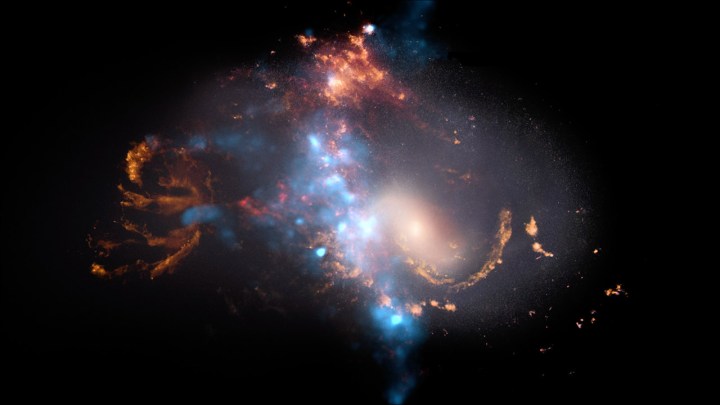One of the first targets observed by the James Webb Space Telescope when it began science operations last year was Stephan’s Quintet, a group of five galaxies locked close together in a complex structure. Now, that data from Webb has been combined with data from other telescopes to give a new view of this special object — and even to create a way to listen to it.
The project used the infrared data from Webb combined with visible light, X-ray, and other infrared observations from the Hubble Space Telescope, the Spitzer Space Telescope, and the Chandra X-ray Observatory. By combining all these different views of the same object, researchers were able to create a 3D view of the group which is visualized in a video:
The idea is to help both scientists and the public get a better understanding of this special group of galaxies. “Shifting from a 2D image to a 3D medium can help viewers really understand the structure of Stephan’s Quintet,” said leader of the team, visualization scientist Frank Summers of the Space Telescope Science Institute, in a statement. “Each observatory that has spent time looking at these five galaxies has enabled us to gather diverse insights and form richer stories about this complex, compact group.”

As well as the visualization, another way in which you can experience Stephan’s Quintet is through sonification. This takes a visual image and interprets it through sound. In this case, the sound starts at the top of the image and then moves downward, with the pitch being higher for brighter sections and lower for dimmer ones, and the galaxies represented by changing frequencies. The different types of objects within the image are also given different sounds, with a marimba for the stars and background galaxies and cymbals for the closer, brighter stars which have diffraction spikes.
The result is an audio file that in some way captures the image, with its different wavelengths showing features of the galaxy group.
“Astronomy has always been very visual, but there’s no reason why we have to represent the data through that manner alone,” said leader of the sonification, Kimberly Arcand of the Chandra X-ray Center. “This type of depiction is taking the scientific story of Stephan’s Quintet — the deep, dense, and beautiful dataset — and translating it into an auditory experience.”
Editors' Recommendations
- James Webb telescope peers at the atmosphere of a rocky hell world
- James Webb captures the edge of the beautiful Horsehead Nebula
- The expansion rate of the universe still has scientists baffled
- See what James Webb and Hubble are observing right now with this tool
- This famous supernova remnant is hiding a secret



